|
Shandy Press ~ Pennsylvania
(Susan Viguers)
|
Share this page: |
| |
|
| INLIQUID art +Design: "Susan Viguers’ artists’ books (and prints) always entail text. She is interested in the relationship (sometimes fusion) of words and images, the way image-making processes mold images, the pacing of narrative, and the way structure realizes that movement. The goal of her art making is the evocation of what can’t be expressed—beyond word/image/structure. She began her career as a scholar/writer and teacher of literature and writing. Her move into art came much later; she served as Director of the MFA Book Art/Printmaking Program at the University of the Arts for nine years." |
| |
|
Surviving Genocide
the 1994 Genocide of the Tutsi
By Susan Viguers and Lily Yeh
Philadelphia, PA: Shandy Press / Barefoot Artists, [2017].
First Edition.
7.5 x 9.25"; 144 pages. Soft cover. Typefaces: Constantia and Lucinda Sans. Printed on White Finch Opaque Smooth Book 100# paper. Digital printing by Bookmobile, Minneapolis, MN. Perfect bound (pur glue).
Shandy Press: "'Surviving Genocide' immerses the reader in the stories of two Rwandans who as small children experienced the 1994 Genocide; it tells of the horrific tragedy each survived, the courage necessary for surviving, and the humanity they embody. Those stories are framed by two chapters chronicling and inspired by the transformation in Rugerero of a concrete burial slab into a powerful Genocide Memorial with its bone chamber, designed by Lily Yeh. An essential theme of the book is the importance of the dead for the living, of honoring the dead, of remembrance.
"'Surviving Genocide' evokes its world through images (photographs, drawings, paintings, pattern, and color) as well as words; the text itself is visually choreographed.
"The material in the book stems from Lily Yeh’s multifaceted Rwandan Healing Project under the auspices of Barefoot Artists www.barefootartists.org . Susan Viguers conceived and designed the book, incorporating drawings and paintings by Lily Yeh.
"This book was made possible by a Rockefeller Foundation Bellagio Arts Residency."
$40 |
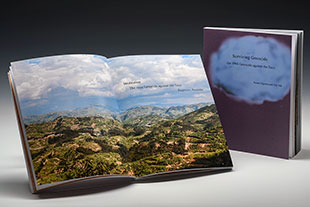 Click image for more
Click image for more |
| |
|
| |
|
The Opossum: A Specimen Book
By Susan Viguers
Philadelphia, Pennsylvania: Shandy Press, 2015. Edition of 25.
6 x 8"; 62 pages. Letterpress printed, using polymer plates, on a Vandercook Proofing Press. Typeface is Hoefler. Text paper is Schiller. Paper for prints is Zerkall. Tip-ins. Bound in unbleached abaca handmade by Nicole Donnelly. Signed and numbered by the artist.
Susan Viguers: "The Opossum is a specimen book in various ways. Most obviously, it is about a particular animal, the Virginia opossum. Conceived in the tradition of the type specimen book, it is a compendium of voices/observations about the opossum. The preface to the book consists of a statement by John D. Godman in 1831: 'Perhaps nothing can more clearly demonstrate the impatience of the human mind, and the reluctance with which men yield to the hard necessity of carefully observing the operations of nature, than the history of this animal.' The primary text, my own story of encounters with the opossum, is surrounded by passages from commentators from the 17th century to the present. I am interested in the fantastical as much as the actual.
"The book is also an exploration into the history of illustrations of the opossum, as well as a collection of printmaking (and art making) processes in service of illustrating the opossum. Original prints representing various media by nine artists are tipped in as are reproductions of various images, primarily engravings from 18th and 19th century books. Credits, media, and discussion relating to the prints are included with thumbnails toward the end of the book.
"Finally, it is a sampling of historical features of the book: the 18th and 19th century exuberant title page, the use of the golden section for page design, the tradition of commentary text surrounding a primary text, and the limp-vellum type binding."
Susan Viguers, backstory: "The origins of the book go back to 1985 to several encounters with opossums, beginning with discovering one moseying around in my kitchen, then, a few days later, another, sitting next to our cat in the passageway to the basement waiting for breakfast, and, a week later, another inside the piano on which our daughter had started practicing.
"I began keeping a folder about opossums not because I wanted to become an expert, but simply because what I was stumbling on was so remarkable: 'The statement that opossum copulate through the nose and then, sometime later, the tiny young are blown into the pouch is entirely false' in an academic book published by Johns Hopkins University Press in 1968 (!); the Reverend Wood's chapter on opossums in his 1885 Animate Creation with its wonderful phrasing (e.g., 'on the fifteenth day after the young have been called into existence'); an image of Isaac Witkin's bronze sculpture Ode to an Opossum from a gallery exhibition; the antipathy some people expressed for opossums.
"But what actually launched the creation of the book was a writing prompt I gave my class, in which as usual I also participated - a prompt that led to pairing my story with other texts. That conjured up for me an image of a typical medieval book. The research in which I then became engaged expanded to opossum illustrations and an interest in what images, as much as text, reveal about perceptions of this generally unappreciated animal."
$800 |
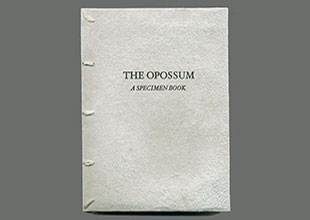
Click image for more
|
| |
|
| |
|
Riddle Me This
By Susan Viguers
Philadelphia, Pennsylvania: Shandy Press, 2013. Edition of 30.
6.75 x 9" closed, extends to 52"; 12 pages. Double-sided accordion. Zerkall text paper. Gill Sans typeface. Letterpress and screenprinted. Bound in handmade papers by Saint-Armand paper mill in Montréal. Signed and numbered.
Susan Viguers: "[Riddle Me This] is a circular accordion book, on one side of which is printed riddles (letterpress) and on the other side the answers (screenprint) in visual form. The text is inspired by Anglo-Saxon riddles, short poems which are not so much verbal tricks, or tests of sharpness, as explorations of everyday objects/experiences usually taken for granted. The structure and directional images move the reader to a comically collaged panorama (photography based) of answers, from a doorknob to a sneeze to an autumn leaf.
"For example, the first riddle explores the experience of a doorknob: 'You clasp me as you would a hand, a closed hand. You turn me as you would a jar. I am the gatekeeper.'
"The book is bound so that it can be displayed standing open, making it possible in a public venue for the reader to walk around and experience both sides, riddles and images.
"The colophon, in the form of a riddle, is a definition of the artist's book."
$275 |
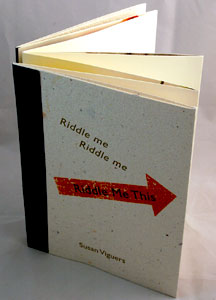 Click image for more
Click image for more |
| |
|
| |
|
Tiptoe Through the Cosmos
By Susan Viguers
Philadelphia, Pennsylvania: Shandy Press, 2008. Edition of 15.
11 x 9.5"; 12 pages. Accordion structure. Letterpress printed on a Vandercook Proofing Press using polymer plates onto Stonehenge paper. Optima font with Sabon italics. Plate lithographs printed on a Charles Brand Press. Soft cover with removable spine.
Susan Viguers: "This is a book of nonsense that shades gradually (and partially) into meaning. The imagery seeks to conflate or merge the earth with the heavens. The text's consciousness of the structure of the book itself - the gutter, the edge of a page – adds to the literalism that is always a part of nonsense. In the end, the book is a comic hymn to the objects and creatures of the everyday (and nature): the earthworm, the embodiment of the worthy meek, ventures into the cosmos (the flower, but more prominently, the heavens).
"Behind this book is a scholarly essay I published 25 years ago ("Nonsense and the Language of Poetry"), in which I argued that there is a connection between nonsense (I was thinking of Edward Lear and Lewis Carroll) and metaphor in that in figurative language meaning is only possible with the acknowledgement of the element of nonsense. (If it makes perfect "sense," then it becomes a dead metaphor.)
"To jump a couple of decades, this text emerged out of a writing exercise I gave my students in which they were asked to create a deck of words that attracted them and play with the words, ,,,I am very fond of earthworms and gardens. Finally, I am sure Tiny Tim's Tiptoe Through the Tulips is an influence.
"In creating the imagery, I was interested, among other things, in the layers of ink. The litho sinks into the page, the letterpress is 'pressed,' the screenprint sits on the surface of the paper."
$275 |
|
| |
|
| |
|
On Collecting
By Juan Sebastian Agudelo
Philadelphia, Pennsylvania: Shandy Press, 2004. Edition of 75.
8.25 x 6" closed. The structure is a modified accordion, with an extra flap attached at the top, adding to the sense of unfolding layers of stamps before one gets to the text. The poem can be read by turning the pages as in a codex structure, but as an accordion, the parts also exist horizontally as in a time line, echoing an underlying movement of the poem. The book was conceived, designed, bound, and the text letterpress printed on a Vandercook Proving Press by Susan Viguers. The type is Walbaum and the paper Dulcet. The images are offset printed by Lori Spencer on a Heideberg KOS in the Borowsky Center for Publication Arts, The University of the Arts, Philadelphia, PA.
The black leatherette cover, size and shape suggest a stamp book. The book does have 23 pages of stamps from around the world from the 1940s to the 1960s collected in Mexico by Guillermo Agudelo. One can "read" the pages: the companionship of the pope and Grace Kelly on the Monaco page, the large fish gliding above the Hitlers, the images of stamps within stamps in the USSR, Mao and Lenin shaking hands, a whole page recording the variations in a Chinese exercise routine.
Within the rich visual and metaphoric context of the stamps, but in its own space, is a poem inspired by the stamps by Juan Sebastian Agudelo-a wry meditation on growing up, the nature of collecting, and a grandfather's legacy to his grandson, and on the political and cultural world to which stamps give voice.
$85
|
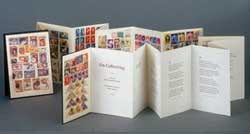
Click image to enlarge
|
| |
|
| |
|
On Lines
By Susan Viguers
Philadelphia, Pennsylvania: Shandy Press, 1997. Edition of 100.
7 x 5" with eight spreads. Font is Frutiger. Ink is dark brown on Speckletone Oatmeal. A folio sheet of heavy handmade paper separates the cover from the body of the book, enclosing the experience in the textured materials of the natural world. Printed at The University of the Arts.
Lines are simple, yet are immensely powerful mathematically, physically, and metaphorically. The meditative offset book of minimal images and text seeks to create in the reader the metaphoric experience of various lines - straight and curved, parallel and intersecting. The process of reading the text and images enacts the metaphoric, as well as physical, movement of the lines, from the horizontal which "moves forward - and sideways - into the future" to curving lines which "create eternity."
$15 |
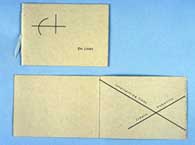
Click image to enlarge
|
| |
|
|
Shandy Press Out of Print Title:
|
|
| |
|
Calling Home
By Susan Viguers & Ruth Viguers Arnold
Philadelphia, Pennsylvania: Shandy Press, 2004. Edition of 25.
9 x 6.25" closed. Sewn-board binding. All pages are pressure-printed, the front in a blue, the back in an ocher, with atmospheric images of telephone poles and lines. Each page spread consists of a front and back page: what is said is on the top, what is thought but unspoken is revealed on the page beneath, through cutouts. The text is laid out in the middle of the spread, across the gutter that divides mother and daughter. The paper is Mohawk Superfine; the type is Gills San for the daughter and Sabon Bold for the mother. Designed, bound, pressure printed and letterpress printed on a Vandercook Proving Press by Susan Viguers.
"Calling Home" chronicles a phone conversation between a daughter in college and her mother. What they say to each other, however, is only part of the story. It is what they think but don't say where the real dynamics lie. It is a story of the complex tension between dependence and independence, between connection and autonomy.
(SOLD) |
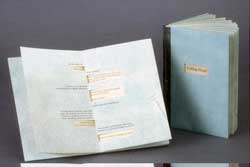
Click image to enlarge
|
| |
|
Falling Shutters
By Susan Viguers
Philadelphia, Pennsylvania: Shandy Press, 2012. Edition of 11.
11 x 4 x 2"; 16 pages. Jacob's ladder construction. Pages made of old wooden shutter slats. Screenprinted. Bound using tyvek. Laid in box of French paper with letterpress colophon and tiles.
Susan Viguers: "Falling Shutters is a 16-piece Jacob's ladder. When this Victorian toy is held up and tipped, the wooden pieces seem to tumble over each other, bringing the back of each piece to the front. In this work, each side consists of a poem about falling shutters. The movement of the ladder is a visual enactment of the poems. Inside the ladder's box are directions (letterpress printed) for handling and an image of one side/one poem in its initial, reading position.
"The wooden pieces are old shutter slats, on which the two poems have been screenprinted. They are in fact the very shutter slats described in the poem, and the experiences are those of the artist."
(SOLD) |
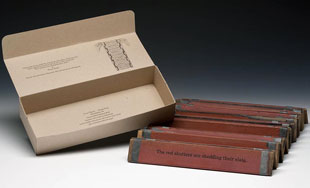 Click image for more
Click image for more |
| |
|
Portrait of a Daughter: Ruth's Room
By Susan Viguers
2002. Edition of 7.
5.6 x 5.6" casebound with thirteen spreads of text and image. Bound in a mottled fabric with caterpillar stitching winding its way across the front, up the spine, and to the back. Images are monoprints. Text is letterpress printed in Goudy Old Style.
"When the world cracked and her father announced he was moving out, my daughter escaped to her room" so begins this narrative. Through an interplay of text and image, it moves on to create that room. With its clutter and beloved objects, insulated from the rest of the house, the room is a cocoon. The vision is a mother's portrait of her adolescent daughter.
(SOLD) |
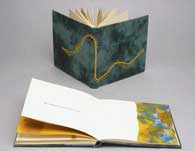
Click image to enlarge
|
| |
|
A Selection of Aesop's Fables
By Susan Viguers & James Engelbart
Philadelphia / Minneapolis: Shandy Press / Snout Press
Philadelphia, Pennsylvania: Shandy Press, 2006. Edition of 100.
6 x 7.75"; 28 leaves printed on recto, verso blank. Images created by James Engelbart using polymer plates and stencils. Designed, printed, and bound by Engelbart & Viguers. Text and image printed on a Vandercook Press. Fonts are New Century Schoolbook and Imprint MP Shadow. Paper is Schiller. Bound in tan bookcloth with paper title label on front board.
Susan Viguers wrote the text by drawing on several collections but primarily on Joseph Jacobs’ The Fables of Aesop (London, 1894). The illustrations, created by James Engelbart of Snout Press, are based on the writings of Pliny the Elder. The book was commissioned by The Friends of the Print Collection of The Free Library of Philadelphia for the 7th annual Robert F. Looney Memorial Event Bound/Unbound.
From the Foreword: "This translation of Aesop is based on the Assemblies of Aesopic Tales of Demetrius Phalareus, the recently discovered scroll that miraculously survived the razings of the Alexandrian libraries....What it shows us is that the genius of Aesop was not only his ability to see truths in the events he transcribed, but also his knowledge of the language of the animals."
( SOLD/Out of Print) |
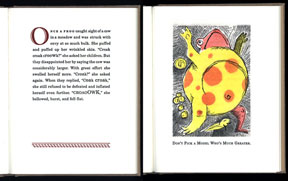
Click image to enlarge
|
| |
|
The Self Inside the House
By Susan Viguers
Philadelphia, Pennsylvania: Shandy Press, 2000. Edition of 45.
6 x 3.5" closed; 13.5 x 6" open. A modified accordion with the first and last spreads sewn in cloth boards. Offset printed on Mohawk Superfine. Set in Goudy.
What is the self and how does one define it? The book plays with the idea of the self as a person inside looking out of a house. It explores the sense of separation between self, which is a constant, and one's body, which can be dressed up or down, which grows, changes, becomes old.
The simple line drawings are of animated windows, the eyes of the house, which dance across the pages. Small inserts sitting inside the larger pages offer brief attendant contemplation's. One contrasts the cross section of a tree trunk with the sapling visible at its center and the impossibility of finding the toddler in any specific part of a diagram of the adult human body.
(SOLD)
|
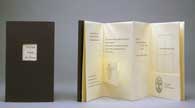
Click image to enlarge
|
| |
|
Spring
By Susan Viguers
Philadelphia, Pennsylvania: Shandy Press, 2004. Edition of 50.
7 x 5 " closed. The type is wood (except for an occasional metal letter), and is letterpress printed on a Vandercook Proving Press. The paper is Rives Lightweight. Written, designed, printed, and bound by Susan Viguers.
"Spring Tongue-Tied the Ocean" captures the wonder of the coming of spring. The season comes slowly as one turns the pages, beginning with the melting of winter: "Weariness burbled and plopped." With each page turn the word SPRING enters from the left, at first just part of the "g" (printed only slightly darker than the page itself) until the final spread where the full word presents itself in a vibrant green. As the letters spelling SPRING deepen in color, the primary text, which expressively dances across each page, turns from almost black to a blue.
(SOLD) |
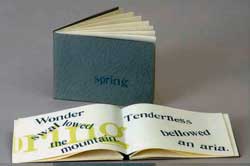
Click image to enlarge
|
| |
|
The Thing Is, You Guys
By Susan Viguers
Shandy Press, 2023, edition size 15.
5 x 6"; 28 pages. Hand sewn binding. Cloth spine with illustrated paper of eco prints over boards. Signed and numbered by the artist.
Colophon: “Conceived, the text drafted, and most of the self-portrait images drawn during an In Cahoots residency, August of 2022. The portraits are blind contour drawings … The color fields were hand stenciled. The text and images were letterpress printed using polymer plates. The typeface is Adobe Garamond Pro. The paper is Schiller.”
Susan Viguers: “’The Thing Is, You Guys’ explores the experience of aging – embarrassing, painful, sad, comical. The brief narratives are presented in the context of blind contour self-portraits and a dirge sung by the author/artist in her childhood, ‘When you ever see a hearse go by’. … The dirge is a ‘song’ – as I remember it from my childhood – which we sang when we saw a hearse drive by.”
A delightful and insightful look at aging. Across the bottom of the pages dance the musical notations from the song “When you ever see a hearse go by remember that some day you’re going to die.” And, so the song continues across the bottom of the pages while the text above reveals the thoughts of one who is realizing that they are aging and the hearse may be coming sooner than later.
Viguers starts her narrative with
The thing is, you guys, you grow old,
But you don’t think you’re old.
THAT’s the problem.
Through the vignettes little nuggets of realization come through such as “My memory is porous, and I no longer trust it” and “We witness dying from the outside.”
(SOLD/Out of Print) |
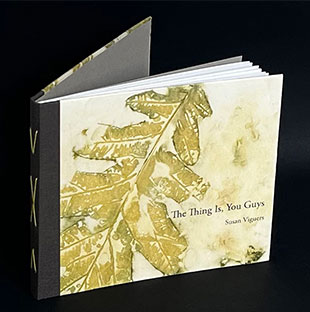 Click image for more
Click image for more |
| |
|
The Universe Tends Toward Disorder
By Susan Viguers
Philadelphia, Pennsylvania: Shandy Press, 2001. Edition of 30.
6.5 x 11" Jacob's ladder. Screenprinted on wood and Tyvek. Laid in 7 x 2 x 1" box letterpress printed on Elephant Hide paper. The ladder is made of old shutter slats which have been repainted and reconnected using the building material Tyvek. Written directions and an image of how to handle the book structure are printed on the box.
On one side of this Jacob's ladder is printed the second law of thermodynamics ("the universe tends toward disorder"); and, below that a sequence of images of a wine glass tipping, falling, and breaking. When one activates the piece, the slats seem to fall, the back is brought to the front; and, thus, "the universe tends toward disorder" is replaced by another law's corollary. "Every motion is potentially reversible" brings with it corresponding images of the broken glass and spilled wine reconstituting itself. Only one side of the ladder is readable at a time. The sides being mutually exclusive, embodying the perception of the impossible tension between the two principles.
As discarded parts of a house come back to life, the materials allude to the fantastical optimism of "every motion is potentially reversible."
(SOLD) |
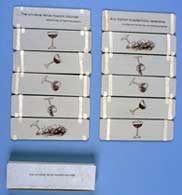
Click image to enlarge
|
| |
|
| |
|
Page last update: 03.29.2025
|
